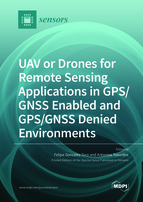UAV or Drones for Remote Sensing Applications in GPS/GNSS Enabled and GPS/GNSS Denied Environments
A special issue of Sensors (ISSN 1424-8220). This special issue belongs to the section "Remote Sensors".
Deadline for manuscript submissions: closed (30 June 2020) | Viewed by 73804
Special Issue Editors
Interests: remote sensing; UAV; unmanned aerial systems (UAS); bioinspired optimisation; multidisciplinary design optimisation; optimisation; drones; wildlife monitoring; precision agriculture
Special Issues, Collections and Topics in MDPI journals
Interests: unmanned aircraft systems; decision making on multi-agent systems; data-centric guidance and control; swarm
Special Issues, Collections and Topics in MDPI journals
Special Issue Information
Dear Colleagues,
The design of novel UAV systems and the use of UAV platforms integrated with robotic sensing and imaging techniques, as well as the development of processing workflows and the capacity of ultra-high temporal and spatial resolution data have enabled a rapid uptake of UAVs and drones across several industries and application domains.
The scope of this issue provides a forum for high-quality peer-reviewed papers that broaden awareness and understanding of single and multiple UAV developments for remote sensing applications, and associated developments in sensor technology, data processing and communications, and UAV system design and sensing capabilities in GPS enabled and more broadly Global Navigation Satellite System (GNSS) enabled and GPS /GNSS denied environments.
Prospective authors are invited to contribute to this Special Issue of Sensors (Impact Factor: 2.475 (2017); 5-Year Impact Factor: 3.014 (2017)) by submitting an original manuscript.
Contributions may focus on, but are not limited to:
- UAV-based photogrammetry, laser scanning, multispectral imaging, hyperspectral imaging, and thermal imaging;
- UAV sensor applications, spatial ecology, pest detection, reef, forestry, volcanology, precision agriculture wildlife species tracking, search and rescue, target tracking, the monitoring of the atmosphere, chemical, biological, and natural disaster phenomena, fire prevention, flood prevention, volcanic monitoring, pollution monitoring, microclimates, and land use;
- Wildlife and target detection and recognition from UAV imagery using deep learning and machine learning techniques;
- UAV-based change detection;
- Sense and avoid;
- UAV navigation in cluttered environments;
- Single and multiple UAVs or swarms in GPS /GNSS denied environments;
- On-board decision making;
- Real-time georeferencing for UAV-based imaging;
- Radiometric and spectral calibration of UAV-based sensors;
- UAV onboard data storage, transmission, and retrieval;
- Collaborative strategies and architectures to control multiple UAVs and sensor networks for the purpose of remote sensing.
Dr. Felipe Gonzalez Toro
Prof. Dr. Antonios Tsourdos
Guest Editors
Manuscript Submission Information
Manuscripts should be submitted online at www.mdpi.com by registering and logging in to this website. Once you are registered, click here to go to the submission form. Manuscripts can be submitted until the deadline. All submissions that pass pre-check are peer-reviewed. Accepted papers will be published continuously in the journal (as soon as accepted) and will be listed together on the special issue website. Research articles, review articles as well as short communications are invited. For planned papers, a title and short abstract (about 100 words) can be sent to the Editorial Office for announcement on this website.
Submitted manuscripts should not have been published previously, nor be under consideration for publication elsewhere (except conference proceedings papers). All manuscripts are thoroughly refereed through a single-blind peer-review process. A guide for authors and other relevant information for submission of manuscripts is available on the Instructions for Authors page. Sensors is an international peer-reviewed open access semimonthly journal published by MDPI.
Please visit the Instructions for Authors page before submitting a manuscript. The Article Processing Charge (APC) for publication in this open access journal is 2600 CHF (Swiss Francs). Submitted papers should be well formatted and use good English. Authors may use MDPI's English editing service prior to publication or during author revisions.








